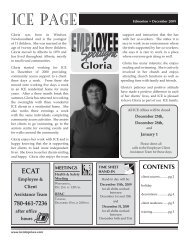form - Independent Counselling Enterprises
form - Independent Counselling Enterprises
form - Independent Counselling Enterprises
Create successful ePaper yourself
Turn your PDF publications into a flip-book with our unique Google optimized e-Paper software.
December 2007<br />
Health Corner WINTER<br />
Unlike most weather conditions,<br />
cold weather is unforgiving and<br />
merciless. If you mistakenly go<br />
out on a spring day without an<br />
umbrella, you might end up with<br />
pneumonia but the likelihood is that you<br />
will just have a wet head. On a summer day<br />
without a hat and sun block you could end<br />
up with sunstroke but will probably just<br />
suffer a bad sunburn. In the winter, however,<br />
if you are not adequately prepared for<br />
the conditions, you can very easily end up<br />
without fingers, toes or even your life.<br />
The key to surviving and enjoying your<br />
winter experience is preparation and prevention.<br />
Dress appropriately, know the<br />
weather conditions (including temperature,<br />
precipitation, and the expected wind chill<br />
index), protect your extremities and remove<br />
wet clothing as soon as dry clothes are available.<br />
Three complications of<br />
winter include hypothermia,<br />
frostbite and frost nip.<br />
Hypothermia<br />
This is a condition where the<br />
core body temperature decreases to a level<br />
at which normal muscle and brain functions<br />
are impaired. Your core body temperature is<br />
the temperature of the core of the body (the<br />
heart, lungs, and brain) that is essential to<br />
the overall metabolic rate of the body. The<br />
conditions that can lead to hypothermia include<br />
cold temperatures, wetness, improper<br />
dress/equipment, alcohol intake,<br />
and poor food intake.<br />
There are three levels of<br />
hypothermia: mild, moderate and<br />
severe. With mild hypothermia,<br />
there is mild shivering and the person cannot<br />
do complex motor functions, such as<br />
skiing. With moderate hypothermia, the<br />
person has a slurred speech, violent shivering,<br />
is dazed, irrational and has a loss of fine<br />
motor functions. With severe hypothermia,<br />
the person has pale skin, decreased heart<br />
rate, dilated pupils, rigid muscles,<br />
shivering may stop, falls<br />
to the ground, unable to walk<br />
or may become unconscious.<br />
Then breathing and heart beat<br />
may stop, which may lead to death.<br />
Tips to prevent Hypothermia<br />
• Wear clothes in layers<br />
• Drink warm fluids, and no alcohol<br />
• If you start to sweat, cool off a little. Wet<br />
clothes will accelerate other cold weather<br />
injuries.<br />
• Wear a hat - up to 40% of body heat loss<br />
can occur through the head.<br />
• Wear gloves or mittens or both!<br />
• Wear a scarf to protect the chin, lips and<br />
cheeks - all are extremely susceptible to<br />
cold weather injuries.<br />
What to do in case of Hypothermia<br />
• Remove wet clothing that promotes<br />
hypothermia.<br />
• Get to a warm place as soon as possible.<br />
Use several layers of blankets heated in<br />
your home dryer if possible.<br />
• If the person is alert, give warm beverages.<br />
Never give alcoholic<br />
beverages.<br />
• Seek immediate medical<br />
attention.<br />
Frost Bites<br />
Frostbite is defined as damage of the skin<br />
from exposure to cold weather. Extremely<br />
cold weather can lead to serious complications,<br />
the worst being amputation. Injuries<br />
from frostbite are extremely common, yet<br />
preventable.<br />
Frostbite mostly affects areas where the<br />
circulation is poor. Since cold weather will<br />
cause the body to take preventive measures<br />
by constricting (making smaller) the blood<br />
vessel, this opens the door to frostbite injuries.<br />
Look for the 4 Ps of frostbite:<br />
• Pink - affected areas will be reddish in<br />
colour. This is the first sign of frostbite.<br />
• Pain - affected areas will become<br />
painful.<br />
• Patches - white, waxy feeling<br />
patches show up - skin is dying.<br />
• Pricklies - the areas will then feel<br />
numb.<br />
Tips to prevent frostbite:<br />
• Get to a warm area before frostbite sets<br />
in. If it’s too cold outside, consider staying<br />
indoors.<br />
• Protect areas of poor circulation (ears,<br />
nose, fingers and toes).<br />
• Keep extra mittens and gloves in the car,<br />
or house.<br />
• Wear larger sized mittens over your<br />
gloves.<br />
• Wear a scarf to protect the chin, lips and<br />
cheeks. They are all extremely susceptible<br />
to frostbite.<br />
• Wear two pairs of socks -<br />
wool if possible<br />
• Keep feet warm and dry<br />
• Do not drink alcohol. Alcohol narrows<br />
blood vessels, which promotes frostbite<br />
and then hypothermia<br />
• Remove any wet clothing.<br />
What to do in case of frostbite:<br />
• Do not rub or massage affected areas. It<br />
may cause more damage.<br />
• NOT HOT - warm up the area slowly.<br />
Use warm compresses or your own body<br />
heat to re-warm the area. Underarms are<br />
a good place.<br />
• If toes or feet are frostbitten, try not to<br />
walk on them.<br />
• Seek immediate medical attention if you<br />
see white or grey coloured patches or if<br />
the re-warmed area is numb.<br />
• Always be on the lookout for the symptoms<br />
of frostbite. In case<br />
of serious cold weather<br />
injury, seek immediate<br />
medical attention.<br />
Frost Nips<br />
Frost nip can cause the skin to look very<br />
white and waxy. The top layers of skin can<br />
feel hard, but the tissue underneath will<br />
still feel soft. There may be some<br />
numbness associated with frost nip.<br />
To treat frost nip, gently warm the<br />
affected area by placing it against a<br />
warm body part (your own, another<br />
person or even your dog if you travel<br />
with one), or by blowing warm air on the<br />
affected area.<br />
NEVER rub skin that is affected by frost nip.<br />
Ice crystals <strong>form</strong> within<br />
cells during the freezing<br />
of tissue. Rubbing affected<br />
skin can cause the destruction<br />
of cells as they are torn<br />
from the ice crystals.<br />
Page <br />
www.icenterprises.com







